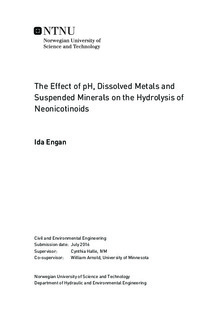The Effect of pH, Dissolved Metals and Suspended Minerals on the Hydrolysis of Neonicotinoids
Abstract
Neonicotinoids are a chemical class of insecticides that is registered in more than 120 countries and widely used all over the world. In recent years, neonicotinoids have been in the spotlight for their negative effects on non-target organisms like pollinating insects and other important ecosystem service providers. Neonicotinoid pollution of aquatic systems has been found in several countries, and under the right conditions, they have been found to accumulate in soils. To better understand the environmental fate and degradation pathways of this important insecticide class, hydrolysis experiments has been performed on two neonicotinoid compounds: imidacloprid and acetamiprid. The objective of the thesis has been to investigate the effects of pH, dissolved metal ions and suspended minerals on hydrolysis rates. The experiments were regularly monitored using HPLC analysis. Both neonicotinoids were found to be persistent in the pH-range 4.0-8.0, in the absence and presence of metal ions and minerals. No degradation was detected during the experimental period. At pH 10.0, both neonicotinoids degraded significantly. Half-lives were found to be 27 and 40 days for acetamiprid and imidacloprid respectively. In the presence of dissolved CuII, NiII, and ZnII, and suspended goethite, kaolinite, and TiO2, the hydrolysis at pH 10 was inhibited, increasing the half-lives with up to 35%.
